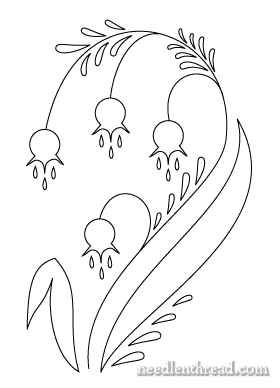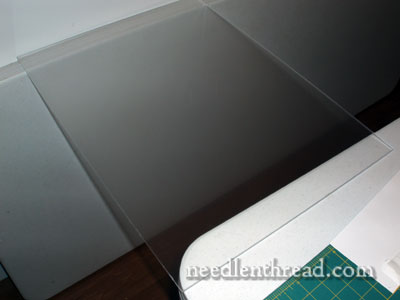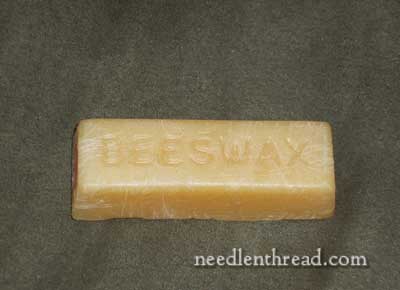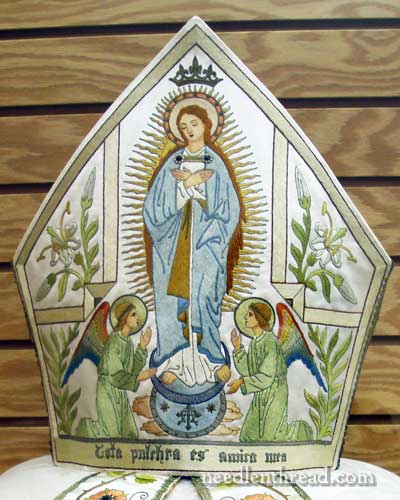December 16, 2010
Free Hand Embroidery Pattern: Hanging Flowers
Here’s a little hand embroidery pattern for you – just a doodle of some simple hanging flowers.

December 16, 2010
Here’s a little hand embroidery pattern for you – just a doodle of some simple hanging flowers.

December 15, 2010
If you’re looking for holiday gifts for your needlework buddies, how about a new book to add to their collection? This isn’t actually a novel idea. My inbox is inundated with questions about holiday gifts for stitchers this time of year – where to find unique needlework-related gifts, book recommendations, shop recommendations, and so forth.
Invariably, I fall back on books as gifts, probably because I’m a book freak, and that would be my preference.
So, if you’re floundering about, wondering what to get a stitching buddy, or if you’re planning on buying your own gift and wrapping it and putting it under the tree and feigning surprise on Christmas morning, I thought I’d give you a list of twelve needlework books that are popular on Needle ‘n Thread. Just for ideas….

December 14, 2010
This past weekend, my goal was to get Proserpina onto fabric so that I could test various embroidery threads and colors, to narrow down some choices.
The first consideration with this embroidery design was fabric choice. Working with Access Commodities, I considered various possible linens as a ground fabric for Proserpina. There are two choices of fabric I’m debating on now – narrowed down from about six.

December 13, 2010
When I lived in a dormitory in college, I was desperate for a light table for tracing embroidery designs. But light tables were way beyond my means. But I had a friend! And he had some left over plexiglass! So he gave me a large sheet of it. It was 1/4″ thick, very stiff, not quite as brittle (or breakable!) as glass, and a whole lot lighter. I put my desk lamp under it, and used the make-shift plexiglass table as my light box. It was GREAT. It was big – about 36″ x 40″ – and it was free. I ended up using it practically permanently as an extension to my desk, even though it meant there wasn’t a whole lot of room left in the room!
I’ve been venturing into some new embroidery projects which I already briefly introduced to you a while ago. The project I’m concentrating on first (“Proserpina”) is about 12″ long, which necessitates either moving the design around on my minuscule plastic light box (which is actually a kid’s tracing box from a local craft store), or finding some other solution to transferring the design. I was a bit frustrated at first…. but then….. wistfully recalling the spent days of my youth, and waxing melancholic over the joys of living in a cramped dorm room, I bethought myself of plexiglass.

December 10, 2010
My sisters and I said that a lot as kids. I guess we thought that “mind your own business” was a bad thing to say… or maybe we thought “mind your own beeswax” was a funny thing to say (We were probably a bit nerdy in that regard.) In any case, it isn’t the most polite thing in the world to say!
I really don’t mean mind your own beeswax. In fact, what I mean is find your own beeswax. Beeswax is an essential ingredient for goldwork embroidery. It’s used to coat the stitching threads that hold the real metal onto the fabric. It helps protect the stitching thread from abrasion. To use beeswax for goldwork, run the stitching thread two or three times through your cake of wax, and then run it slowly through your fingers to smooth out any bumps of wax and kind of “melt” the beeswax onto the thread.
Beeswax is used for other needlework adventures, too. Hand quilters, for example, will often use it to stiffen sewing threads, to smooth them, and to prevent tangling. So it’s not just essential for goldwork – it’s also nice to have on hand in your needlework supplies for other needlework pursuits.
But there’s beeswax for embroidery, and then there’s Beeswax for embroidery. I don’t like the kind of beeswax that flakes all over the place. Even after running the thread through your fingers, inferior beeswax products tends to “peel” and flake off your thread as you stitch, leaving residue behind. No, no. It won’t do! For example, that pale yellow round of “beeswax” that comes in a clear plastic, slotted disk and is widely available in the notions section in sewing stores? There’s just something not right about it. It’s flaky. It’s pale. And did I mention that it’s flaky?
So instead of turning to your sewing notions aisle, where else can you find beeswax for your needlework?

December 9, 2010
Christmas came early for me this year – in the form of an embroidery kit! My First Bambina was visiting thrift stores when she came across an incredible find – for a dollar!! (This never happens to me!)
Being the generous soul that she is, she thought of me and picked the thing up, and mailed it to me! Thanks, Bambina!! And I just had to show it to you, because it’s one of those finds that, had I found it, I would’ve been showing it off to everyone, and rambling on about it for days!

December 8, 2010
Ecclesiastical embroidery always fascinates me! One of my favorite aspects to consider when contemplating different ecclesiastical embroidery pieces is the question of origin. I like to think about – and maybe try to find out about (if possible) – the origins of the piece, the origin of the designs and patterns used, and so forth. I also like to compare and contrast different pieces, especially those from different places. I’m always excited to find similarities between pieces, such as the similarities between these two embroidered faces of Christ, one from a museum in California and the other from a museum in Missouri.
Along those lines, I thought I’d show you pictures of two embroidered mitres that are very similar. I took a bit of liberty with the photos, and, playing around in Photoshop, I put them together so that you can see how similar they really are.
